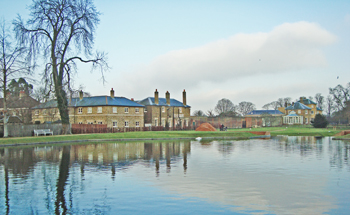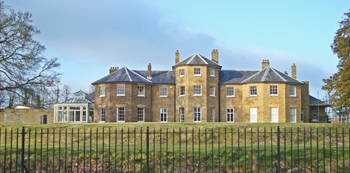Open Air School
After the end of WW1, when the King's Canadian Red Cross Special Hospital was demobilised in September 1919, the Canadian Red Cross offered the buildings and equipment to the King.
The King, in turn, offered them to the LCC for ten years for use as a residential school for 300 delicate boys.
The King's Canadian Residential Open Air School opened at the end of 1919.
The main building - Upper Lodge - became the staff quarters. It also contained the kitchen, the dining hall and rest room for the boys. Flanking one side of the house were the boys' dormitories, medical and dental rooms, the sick ward, the baths, and a large kitchen garden, which supplied fresh fruit and vegetables. On the other side of the house were a lecture hall, lawns, flower gardens and, beyond, an isolation hut. Further on were woods, pools and streams.
The School was open all year round, except for a fortnight at Christmas. Whenever possible the children spend their time out-of-doors. Pigs, sheep, poultry and tame mice were kept at the School. Rabbits made their own burrows within their enclosure in the grounds. There was also an aviary full of birds, and a pond with swans, ducks, geese and wild fowl. A small river had been dammed to form two bathing pools - one for swimmers and one for non-swimmers.
The children were selected by their own school doctors, who decided if a child needed a change of air. Parents were expected to pay towards the cost of the stay, according to their means (which was assessed by the Care Committee of the School), and also had to sign an agreement to allow their child to have medical or dental treatment, if necessary.Each child was instructed to bring an overcoat, sand shoes or slippers, a change of underclothing, a hairbrush and comb, a face flannel, two nightshirts or pairs of pyjamas, two pairs of stockings, six pocket handkerchiefs, a toothbrush and a small collapsible basket or scout satchel to contain the kit.
A local doctor examined the boys when they arrived and also visited the School regularly. A dentist also visited regularly and two qualified nurses lived-in.
Each week 70 boys were admitted and usually stayed for four weeks. Each party arriving at the School formed a house, of which there were four - King's, Queen's, Canada and Bushy. Each house competed for weekly sports and other trophies.
The boys got up at 07.00 hrs and went to bed at 20.00. Breakfast was served at 08.00, dinner at 12.15, tea at 16.00 and supper at 19.00.
Parents were allowed to visit on the third Saturday of the boy's stay, although an alternative date could be arranged with the Director of the School.
On Saturday evenings, if the weather allowed, a bonfire was lit in the woods and the children enjoyed songs and yarns by the campfire.
On Sundays the children were taken to a place of worship in accordance with the denomination the parent had entered on the admission card.
Cinema shows and wireless (radio) concerts were held in the lecture hall and, once a week, a concert was given by those boys on the fourth week of their stay who were about to leave.
The School closed in 1939 on the outbreak of WW2.
Present status (February 2010)
The buildings remained unused until
1942, when the United States entered the war. The US 8th Army Air
Force took over the site as its headquarters, renaming it Camp Griffiss,
after Lt Col
Townsend Griffiss,
the first American airman to be killed in the line of duty in Europe.
In 1944 the Supreme Headquarters of the Allied Expeditionary
Force (SHAEF) under the command of General
Dwight Eisenhower moved to Bushy Park. The
initial planning stages of the allied invasion of Normandy, code-named Operation
Overlord, took place here.
In 1945 control of Upper Lodge was transferred from the Air Ministry to
the Admiralty. It became part of the Admiralty Research Laboratory;
the Longford River (a canal which fed the pools of the Water Gardens)
was diverted so that the still water could be used for testing mines.
By 1963 most of the temporary hutments used by the Hospital and the
camps had been cleared from the site.
In 1994 the Ministry of Defence relinquished the lease of Upper Lodge
to the Crown Estate.
Upper Lodge and the stables were sold for residential development and
are now apartment blocks.
Bushy Park remains a public park.

Upper Lodge, with its conservatory, is on the right of the image, with the stable buildings on the left.

The rear elevation (above) and the side elevation (below) of the Grade II listed Upper Lodge, as seen from Bushy Park. Built around 1840, the mansion is part of the Crown Estate and was a 'grace and favour' home until 1915. It was sold for almost £8.85m.


The extensive stables buildings were used for staff accommodation.

The restored Water Gardens in Bushy Park were opened to the public in 2009.
Franklin G 2009 Inner-London Schools 1918-1944: A Thematic Study. Portsmouth, English Heritage.
Gater GH 1926 London's School in the Country. The King;s Canadian Residential Open-Air School. London, LCC.
http://collage.cityoflondon.gov.uk
http://en.wikipedia.org
www.independent.co.uk
www.royalparks.org.uk
www.telegraph.co.uk
www.twickenham-museum.org.uk
Return to alphabetical list
Return to home page